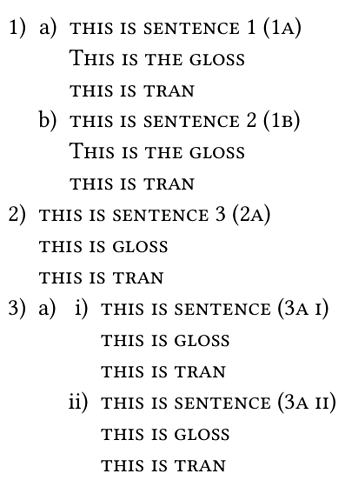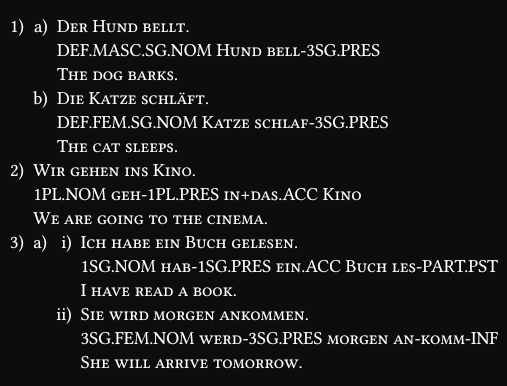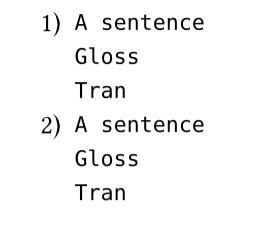Hi all,
I am a linguist, and I would like to use Typst to make linguistic example lists. An example is just a 3-tuple with sentence, gloss, and translation values. Often, it can also just be a single “sentence” value if it’s English. Printing this via a grid is simple enough:

In linguistics papers, these sorts of examples can be arbitrarily nested. For example, we could refer to examples below as 1a), 2b.i), 3), etc.
1) a. [SENTENCE]
[GLOSS]
[TRANSLATION]
b. ...
c. ...
2) a. ...
b.
i. [SENTENCE]
[GLOSS]
[TRANSLATION]
ii. ...
iii. ...
3) [SENTENCE]
[GLOSS]
[TRANSLATION]
As you might expect, I don’t want to type these out manually every time I write an example. I want to make a function that can print the formatting from an arbitrarily nested list of examples, like the list below:
#let xlist = (
// Top-level "1)"
(
// 1a
(sentence: [this is sentence],
gloss: [This is the gloss],
tran: [this is tran]
)
// 1b
(sentence: [this is sentence],
gloss: [This is the gloss],
tran: [this is tran]
)
),
// Top-level "2)"
(
// 2a
(sentence: [this is sentence],
gloss: [this is gloss],
tran: [this is tran],
)
)
I figured this could be accomplished with grid(), but I am lost on how to dynamically allocate grids. I thought about looping over the examples, nesting grid() calls, but I quickly became stuck. I know that each level of the list should have 2 columns (one for label, one for content). Then, the number of rows should depend on how what’s inside the current level of the list.
// Pass in list of examples
#let ex(examples) = {
grid(
columns: 2, // two top main cols
rows: examples.len(), // number of top-levels (i.e., 1, 2, 3)
column-gutter: 1em,
row-gutter: 1em,
for example in examples {
// ??
}
)
I’m having the feeling it might be good to use a recursive solution, but I am new to Typst, and thought I should ask for some guidance before I go too far in that direction. Does anyone have guidance as to how to make such a function, or if another solution would be better? Any help would be much appreciated! Thank you.


